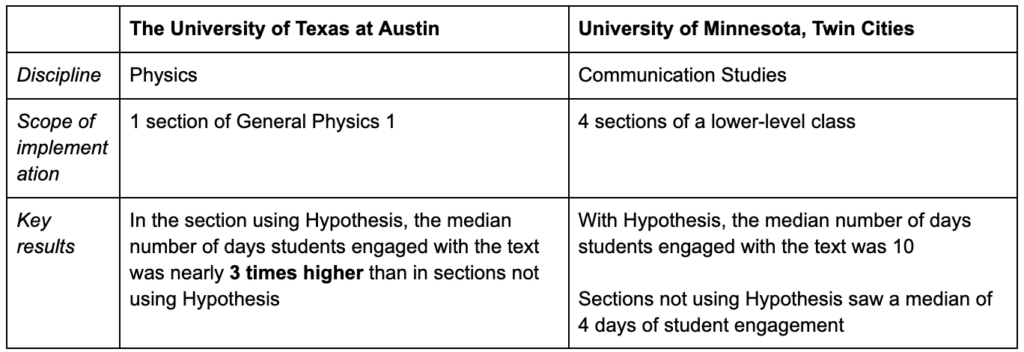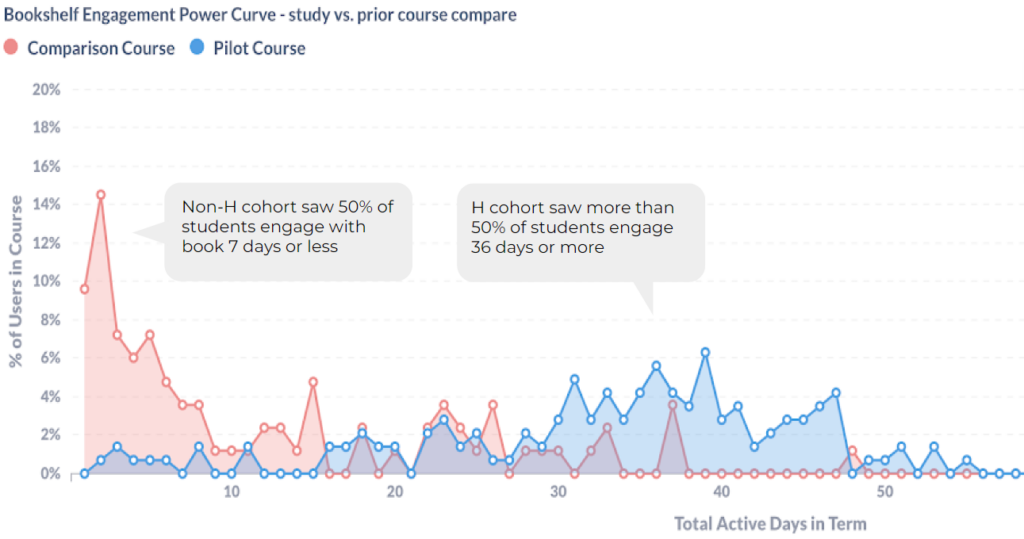
Viranga Perera
Assistant Professor of Instruction in the Department of Physics, UT Austin

Allison Brenneise
Professor in the Department of Communication Studies, University of Minnesota, Twin Cities

Nick Brown
VP of Product. VitalSource
Making digital texts come alive with social annotation
Like many colleges and students across the country, the University of Minnesota and The University of Texas at Austin have turned to Bookshelf by VitalSource to provide students with access to affordable, accessible, and impactful digital course materials.
To foster engagement, community, and critical thinking skills, both institutions leveraged Hypothesis’s integration with Bookshelf to engage students more deeply with texts in a digital environment.
Case studies: Bookshelf by VitalSource and Hypothesis integration

Challenge
No matter the discipline, reading isn’t just one piece of the learning experience, sitting neatly alongside activities like class discussion, assignments, and student-instructor interaction. Rather, reading is the fuel that powers the entire journey.
“Reading isn’t just a bonus — it’s a fundamental part of being an educated person,” says Viranga Perera, Assistant Professor of Instruction in the Department of Physics at UT Austin.
“Making annotations even a small percentage of the grade is enough to get students to pay attention and do the readings.”
– Viranga Perera, Assistant Professor of Instruction in the Department of Physics at UT Austin
To Perera, reading’s importance goes beyond being a necessity. It determines what teaching and learning look like in the classroom. “Reading prepares students for the lecture. We have a lot of material to cover. When they’re reading, we’re a step ahead; we can focus on solving more challenging problems and getting into real-world applications,” he says.
Perera’s not alone. “Getting students to engage with the text sets the tone for everything else in the course,” says Allison Brenneise, Professor in the Department of Communication Studies at the University of Minnesota, Twin Cities.
Despite teaching in vastly different disciplines, Brenneise and Perera share something else in common: they recognized that students weren’t doing the reading, and they decided that something would have to change.
“A lot of students say, ‘Oh, I’m just going to go watch a YouTube video.’ But critical details get missed when students don’t read technical material from a textbook,” says Perera.

An analysis of courses at UT Austin revealed that students had a much greater tendency to engage with the text in sections that used Hypothesis compared with students in sections that did not.
Solution
Like many institutions, the University of Minnesota and UT Austin partner with VitalSource to provide students with affordable, accessible digital course materials. With more than 18 million users annually, Bookshelf is The Premier Global Digital Content Platform.
Brenneise and Perera each saw the potential impact of using the Hypothesis social annotation tool in tandem with Bookshelf by VitalSource — something that became possible in 2022 when the organizations launched their integration.
Implementing Hypothesis and Bookshelf by VitalSource
At the University of Minnesota, Brenneise made sure her students got off on the right foot by having them annotate the syllabus. “Everyone’s a social annotation champion after this assignment,” she says.
Then, she has her students move on to annotating Bookshelf by VitalSource texts. Two of her favorite use cases: Conducting “silent discussion” by having students synchronously annotate the text, and bringing questions to her attention by using Hypothesis’s tagging feature.
“The tags tell me whether a question is for me, or if it’s something the student wants to bring up during class discussion,” she says.
At UT Austin, Perera took advantage of Hypothesis’s streamlined user interface as well as its integration with his institution’s LMS, Canvas. “Setting up the readings is easy, and from there, Hypothesis does a good job of staying out of the way while students engage with the text,” he says.
Wanting to drive usage, Perera decided to give students some incentives.
“Making annotations even a small percentage of the grade is enough to get students to pay attention and do the readings.”
Results
Both UT Austin and the University of Minnesota achieved incredible results with the help of the Hypothesis and Bookshelf by VitalSource integration.
UT Austin
In any course, students engage with the text with varying degrees of frequency. A “power user curve” offers a way to visualize engagement with the text not only across this spectrum of students but throughout the term. A power user curve of Perera’s course reveals that his students showed a much higher level of engagement over time than students in sections of the same course not using Hypothesis.
In Perera’s sections using Hypothesis, the median number of days that students engaged with the text was more than 3 times higher than in sections of the same course that did not use Hypothesis.

“The amount of engagement in this course is outstanding. It’s in the upper echelon looking across every course at every institution we power. I love to see how much these students are getting out of their textbooks,” says Nick Brown, VP of Product, VitalSource.
In addition to the data, Perera observed a number of key benefits and outcomes:
Hypothesis helped students understand course material more deeply. “Because students came to class knowing the basics, we could spend class time talking about the meaning of what they read,” says Perera.
Students took charge of their learning. “There are certain things that I want students to learn — things that are part of education but not directly part of the course. This is one of them.”
Students saw the purpose of reading. “Hypothesis gives students the chance to see how reading can give them an advantage. They learn that, by engaging with the material before they come to class, they can use the lecture to solidify their understanding.”
University of Minnesota
In Brenneise’s sections that used Hypothesis — across multiple years and multiple texts — students were more likely to engage with the text than in sections of the same course taught by Brenneise that did not use Hypothesis.
On average, in sections using Hypothesis, the median number of days that students engaged with the text was 10, compared to an average median of only 4 days in sections not using Hypothesis.

To Brenneise, the impact of using Hypothesis and Bookshelf by VitalSource together was clear.
- Students didn’t just read the text — they took positions on it. “The exciting part, to me, is how students feel more comfortable taking different positions in their annotations. They learn how to disagree with each other without shutting down,” Brenneise says.
- Improved writing and critical thinking skills. “Hypothesis leaves students with a clearer idea of what makes a good argument, and how they might be able to leverage that in their own writing.”
- Learning took on more meaning. “With Hypothesis, students learn how powerful it is for their peers to read their work and give feedback. They become more invested in what they’re doing.”
Want to learn how social annotation can drive etext engagement?
Visit web.hypothes.is or email education@hypothes.is to schedule a brief demo and learn more about our integration with Bookshelf by VitalSource.
About Hypothesis
Hypothesis is a new effort to implement an old idea: A conversation layer over the entire web that works everywhere. The Hypothesis social annotation tool is used by over a million people around the world who have made over 45 million annotations. In higher education, more than 400 colleges and universities use Hypothesis.
About VitalSource
VitalSource is the leading education technology solutions provider committed to helping partners create, deliver, and distribute affordable, accessible, and impactful learning experiences worldwide.

